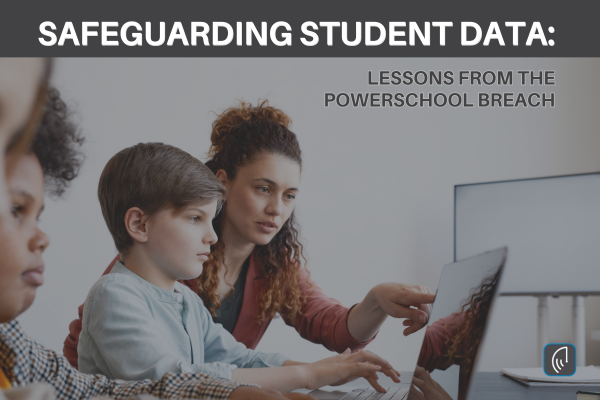The rise in cyberattacks targeting educational institutions has exposed vulnerabilities that threaten the privacy and security of students, staff, and families. Notable incidents like the PowerSchool data breach reveal the need for robust protection mechanisms. This guide looks at the risks, impacts, and strategies to safeguard against Identity theft in educational institutions.
Understanding Identity Theft in Education
Identity theft involves the unauthorized acquisition and misuse of personal information, often for financial or criminal activities. Identity theft in educational institutions is particularly concerning due to the large volumes of sensitive data stored, including Social Security numbers, financial records, and academic details.
Educational settings are prime targets for cybercriminals because they rely on digital platforms and legacy systems. By understanding the causes and solutions, students and institutions can mitigate risks effectively.
Key Statistics:
- 74% of education data breaches occur in colleges and universities.
- Students aged 18–24 are five times more likely to experience identity theft compared to older adults.
- The Federal Trade Commission (FTC) highlights that younger victims take longer to detect fraud, leading to more severe consequences.
The PowerSchool Data Breach: What Happened?
Incident Overview
PowerSchool, a leading educational software provider, suffered a significant breach in 2024. Hackers accessed sensitive data from multiple institutions, exposing student’s and staff’s personal information.
Data Compromised
- Names and contact details
- Social Security numbers
- Academic and health records
Impact
The breach disrupted the operations of numerous schools and heightened the risk of identity theft for millions of individuals.
Why Educational Institutions Are Vulnerable
Outdated IT Systems
Legacy software lacks modern encryption, multi-factor authentication, and regular updates, creating entry points for hackers.
Mandatory Data Sharing
Students frequently provide sensitive information like Social Security numbers for admissions, financial aid, and enrollment processes. This centralized data storage becomes a liability if improperly secured.
Increased Online Presence
The widespread adoption of remote learning platforms and public Wi-Fi networks has expanded attack surfaces for cybercriminals.
Cybercriminal Tactics Targeting Students and Institutions
Phishing Scams
Deceptive emails and fake websites trick students and staff into revealing credentials or clicking malicious links.
Public Wi-Fi Exploitation
Unsecured campus networks allow hackers to intercept transmitted data, such as login details and financial transactions.
Social Engineering
Fraudsters manipulate individuals through deceptive interactions, gaining unauthorized access to sensitive information.
Consequences of Identity Theft in Educational Institutions
For Students
- Financial Losses: Fraudulent loans and ruined credit scores.
- Academic Disruptions: Altered academic records or delayed graduation.
- Emotional Impact: Stress and anxiety stemming from identity theft.
For Institutions
- Legal Penalties: Noncompliance with laws like FERPA can result in significant fines.
- Reputational Damage: Loss of trust from students, parents, and stakeholders.
- Operational Costs: Expenses for damage control and system upgrades.
Technological Solutions for Identity Protection
Identity Theft Protection Services
Platforms like Defend-ID offer:
- Real-Time Monitoring: Alerts for suspicious activity.
- Dark Web Scanning: Detects stolen data.
- Recovery Assistance: Dedicated teams help restore identities.
Cybersecurity Tools
- Password Managers: Securely store unique passwords for multiple accounts.
- Two-Factor Authentication (2FA): Adds an extra verification layer.
- Virtual Private Networks (VPNs): Encrypts internet connections to prevent data interception.
Practical Tips for Students
- Use Strong Passwords: Combine upper- and lower-case letters, numbers, and special characters.
- Avoid Public Wi-Fi for Sensitive Transactions: Use VPNs to encrypt your activity.
- Shred Documents: Properly dispose of bank statements and credit card offers.
- Enable Account Alerts: Receive notifications for unusual activity.
- Be Social Media Smart: Avoid oversharing personal details online.
Institutional Strategies for Cybersecurity
- Adopt Advanced IT Solutions: Upgrade to systems with robust encryption and 2FA capabilities.
- Conduct Regular Audits: Identify and rectify system vulnerabilities.
- Educate Students and Staff: Offer workshops and resources on cybersecurity best practices.
Legal and Regulatory Frameworks
FERPA Compliance
The Family Educational Rights and Privacy Act (FERPA) mandates strict data protection measures for educational institutions. Noncompliance can result in lawsuits and federal penalties.
General Data Protection Regulation (GDPR)
Institutions with international students must adhere to GDPR guidelines to protect personal data.
Case Studies: Success Stories
University of California, San Diego
This university implemented continuous system monitoring, collaborated with cybersecurity experts, and conducted regular training programs, significantly reducing breaches.
Student-Led Initiatives
Cybersecurity clubs at several universities have raised awareness, helping peers secure their digital footprints through peer-education workshops.
Government Support for Cybersecurity in Education
Funding and Resources
- Grants for upgrading IT infrastructure.
- Public awareness campaigns about cybersecurity threats.
Initiatives
Programs like the Cybersecurity and Infrastructure Security Agency (CISA) provide educational institutions with actionable resources to strengthen defenses.
Future Trends in Cybersecurity
Emerging threats like AI-driven phishing and ransomware attacks demand proactive security measures. Institutions must invest in predictive analytics and threat intelligence to anticipate and mitigate risks.
FAQs on Identity Theft in Education
1. How can I check if my data was part of the PowerSchool breach?
Visit the school’s website or contact administrators for updates. Consider using a breach-checking tool online.
2. What immediate steps should I take if I’m a victim?
- Notify your bank and credit bureaus.
- File a report with the FTC.
- Freeze your credit to prevent new accounts from being opened.
3. Are schools liable for breaches?
Yes, if negligence can be proven. Schools must comply with data protection laws.
4. How can parents help protect their children?
Educate children on cybersecurity, monitor their accounts, and invest in identity theft protection services.
5. What role does FERPA play in data security?
FERPA protects student records and enforces penalties for noncompliance.
Conclusion
The PowerSchool breach is a stark reminder of the growing cybersecurity challenges in education. Students and institutions must adopt proactive measures to safeguard sensitive data. By leveraging advanced technology, adhering to legal frameworks, and fostering a culture of cybersecurity, we can mitigate the risks of identity theft in education.
Call-to-Action
Protect yourself with Defend-ID. Get real-time alerts, dark web monitoring, and recovery support today!
